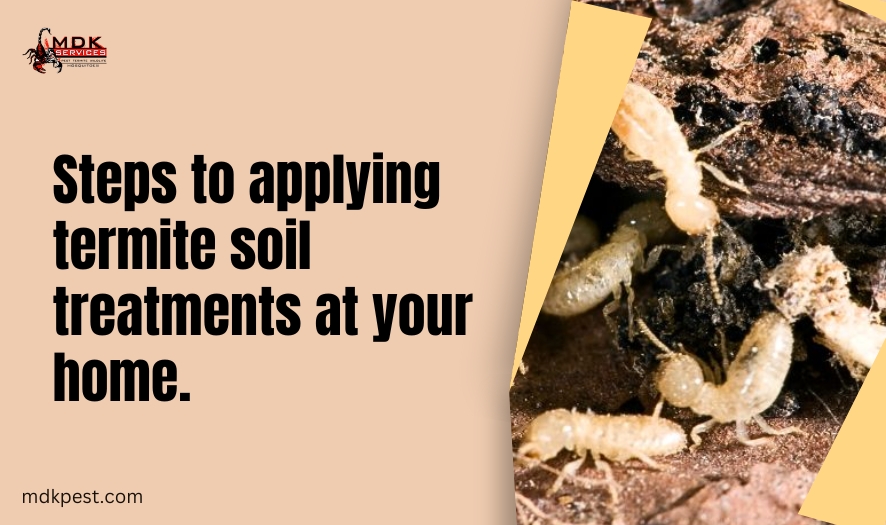
Termite infestations could be on your home, causing significant damage and financial strain if left unchecked. Applying termite soil treatments is a proactive step towards protecting your property and preventing these destructive pests from causing harm. Through this article, we’ll discuss the essential steps of applying termite soil treatments effectively.
Understanding Termite Soil Treatments
What are termite soil treatments?
Termite soil treatments involve applying specific products or techniques to the soil around and beneath a structure to create a barrier that repels or kills termites.
Why are they important?
These treatments create a protective zone that prevents termites from accessing your home’s foundation and structural elements, reducing the risk of infestation and damage.
Types of Termite Soil Treatments
There are several common methods for treating termite infestations in the soil:
Liquid Barrier Treatments
Liquid termiticides are applied to the soil around a structure to form a barrier that termites cannot cross. These treatments are effective but require professional application.
Termite Bait Systems
Bait systems use stations placed in the ground around a structure. Termites consume the bait and share it with the colony, gradually eliminating the infestation.
Chemical Barriers
Chemical barriers involve injecting termiticides into the soil to create a protective zone. These treatments can last for several years and are highly effective.
Assessing Your Termite Problem
Before applying any treatment, it’s crucial to identify the extent of your termite problem:
Signs of Termite Infestation
Look for mud tubes, damaged wood, discarded wings, or hollow-sounding wood.
DIY Inspection Tips
Check for signs of termites in crawl spaces, basements, and around the foundation. Use a flashlight and screwdriver to inspect wooden surfaces.
Preparation Before Treatment
Preparing your home and yard is essential for effective termite soil treatments:
Clearing the Area
Remove clutter, wood piles, and debris from around your home’s foundation.
Protecting Plants and Pets
Cover plants and remove pets from treated areas during application.
Choosing the Right Treatment Method
Consider the following factors when selecting a termite soil treatment:
Factors to Consider
Severity of infestation, environmental impact, cost, and long-term effectiveness.
Consulting with Professionals
Seek advice from pest control experts to determine the best treatment for your situation.
Applying Termite Soil Treatments
Once you’ve selected a treatment method, follow these steps for application:
Step-by-Step Application Process
Dig trenches around the foundation, apply termiticide as directed, and backfill the trenches.
Safety Precautions
Wear protective clothing and follow safety guidelines during application.
Post-Treatment Care and Monitoring
After treatment, monitor your home for signs of termite activity:
Checking Effectiveness
Regularly inspect treated areas for new termite activity or damage.
Follow-Up Treatments
Schedule periodic inspections and reapplications as needed.
Natural Alternatives and Prevention
Explore eco-friendly options and preventive measures to complement your termite soil treatments:
Eco-Friendly Options
Use nematodes, borates, or orange oil as natural termite deterrents.
Preventive Measures
Reduce moisture around your home, seal cracks, and maintain proper ventilation.
Dealing with Persistent Infestations
If termites persist despite treatments, it may be time to call in professionals:
When to Call a Professional
Seek professional help if DIY methods fail or if the infestation is severe.
Additional Treatments
Professionals can offer advanced treatments like fumigation or localized spot treatments.
Cost Considerations
Understand the costs associated with termite soil treatments
Budgeting for Termite Treatments
Factor in initial treatment costs and potential long-term savings from preventing damage.
Value of Professional Services
Evaluate the value of hiring professionals for their expertise and guaranteed results.
DIY vs. Professional Treatment
Consider the advantages and disadvantages of DIY versus professional termite treatments:
Pros and Cons of Each Approach
DIY treatments are cost-effective but may not be as thorough or long-lasting as professional services.
Conclusion
Protecting your home from termite damage requires proactive measures and informed decisions. By understanding the steps involved in applying termite soil treatments and considering your options carefully, you can safeguard your property against these destructive pests effectively.
